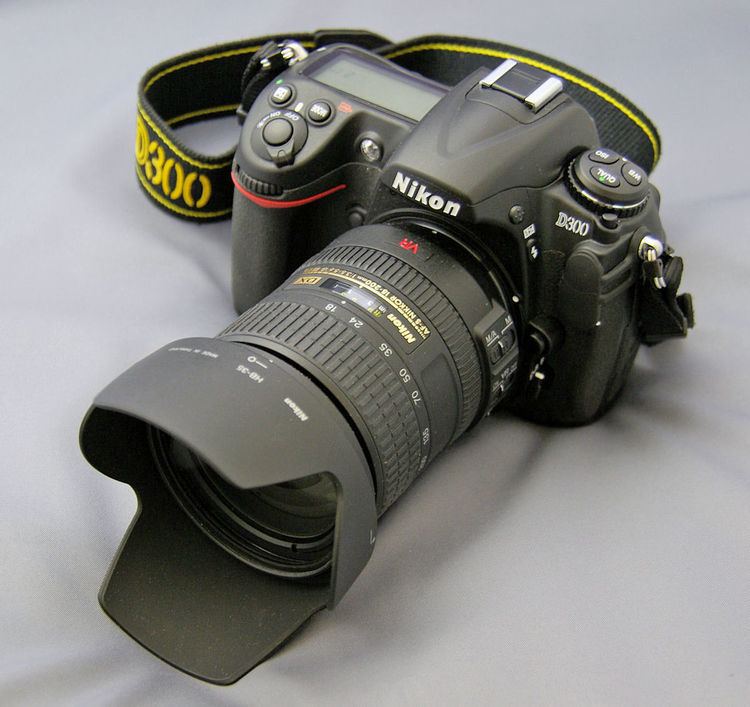 | ||
Type Digital single-lens reflex Lens Interchangeable, Nikon F-mount Sensor Nikon DX format 23.6 mm × 15.8 mm CMOS Maximum resolution 4,288 × 2,848 (13.1 M/12.3 M pixels sensor/effective) ASA/ISO range 200–3200 in 1, 1/2 or 1/3 EV steps (down to 100 and up to 6400 as expansion) Recording medium CompactFlash (Type I or Type II) or Hitachi Microdrive | ||
The Nikon D300 is a 12.3-megapixel semi-professional DX format digital single-lens reflex camera that Nikon Corporation announced on 23 August 2007 along with the Nikon D3 FX format camera. It replaced the D200 as Nikon's DX format flagship DSLR. The D300 was officially discontinued by Nikon on September 11, 2009, being succeeded by the Nikon D300S, which was released July 30, 2009.
Contents
Features
The D300 was designated by Nikon as the ultimate in DX format performance. It is quite similar to the D700, with the main difference being that the D300 uses a DX sensor instead of an FX sensor. It offers both high resolution and high speed (being able to capture 6 frames per second, and 8 frames per second with the addition of an optional MB-D10 battery pack).
The D300 has not only a built-in autofocus motor for all Nikon autofocus-lenses, but includes CPU and metering for older Nikon F-mount AI/AI-S lenses and the new generation perspective control lenses (PC-E).
The built-in intervalometer (timer) can be used for time-lapse low-lit movies.
Specifications
Reception
The Nikon D300 was announced on August 23, 2007. Outdoor Photographer, Shutterbug Magazine, and the UK magazine, "What Digital Camera" presented initial 'First Look' reviews. Imaging Resource and Photocrati also did their own initial reviews. DCR and Camera Labs have full reviews of the D300. Digital Review Canada compares it to the older Nikon D200. Popular Photography named the Nikon D300 for their official "Camera of the Year 2007" award. The magazine also reviewed the camera, and noted at that time that Nikon Capture NX software was packaged with the camera; more recent packages include a 30-day trial version.
MB-D10 Multi Power Battery Pack
The MB-D10 is an optional accessory battery pack that provides a vertical grip as well as additional shutter release and autofocus buttons, command dials and focus point selection control.
The MB-D10 allows the D300 to be powered by an additional EN-EL3e battery or AA batteries. An optional carrier is available which allows for an EN-EL4 or EN-EL4a battery to be installed instead. The camera can be configured to assign priority to either the internal EN-EL3e battery or the MB-D10 grip such that the other battery is used only when the primary battery is dead.
The D300 can shoot 8 frames per second with the MB-D10 & AA/EN-EL4/EN-EL4a battery installed, otherwise the camera is limited to a 6 frames per second 'shooting' mode. The MB-D10 is also compatible with the D700 but not the D200.
'D2X Mode' and firmware upgrade
On January 15, 2008, Nikon released three additional picture control modes for the D300 which emulate the D2X/D2XS color modes I, II and III.
On February 14, 2008, Nikon released a firmware upgrade which resolves an issue where vertical banding can occur when long exposure noise reduction is enabled for shutter speeds of 8 seconds and slower.
Nikon D300 AF system now on Nikon D7100
On February 21, 2013 Nikon announced a new flagship DX format camera (the D300 was the former flagship), The D7100 features the same Mutli-CAM D3500 DX module as the D300. Despite the backlash from D300 enthusiasts unhappy with their camera being replaced as the flagship DX-format camera, Nikon still actively refers to the D7100 as the "new flagship of Nikon's DX-format line-up."
